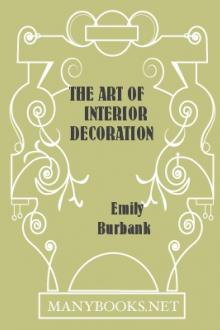The Art of Interior Decoration by Emily Burbank (good summer reads TXT) 📕

- Author: Emily Burbank
- Performer: -
Book online «The Art of Interior Decoration by Emily Burbank (good summer reads TXT) 📕». Author Emily Burbank
PLATE XV Venetian Glass, Antique and Modern.
PLATE XVI Corner of a Room in a Small Empire Suite.
PLATE XVII An Example of Perfect Balance and Beauty in Mantel Arrangement.
PLATE XVIII Corner of a Drawing-room, Furniture Showing Directoire Influence.
PLATE XIX Entrance Hall in New York Duplex Apartment. Italian Furniture.
PLATE XX Combination of Studio and Living-room in New York Duplex Apartment.
PLATE XXI Part of a Victorian Parlour in One of the Few Remaining New York Victorian Mansions.
PLATE XXII Two Styles of Day-beds, Modern Painted.
PLATE XXIII Boudoir in New York Apartment. Painted Furniture, Antique and Reproductions.
PLATE XXIV Example of Lack of Balance in Mantel Arrangement.
PLATE XXV Treatment of Ground Lying Between House and Much Travelled Country Road.
PLATE XXVI An Extension Roof in New York Converted into a Balcony.
PLATE XXVII A Common-place Barn Made Interesting.
PLATE XXVIII Narrow Entrance Hall of a New York Antique Shop.
PLATE XXIX Example of a Charming Hall Spoiled by Too Pronounced a Rug.
PLATE XXX A Man's Library.
PLATE XXXI A Collection of Empire Furniture, Ornaments, and China.
PLATE XXXII Italian Reproductions in Pottery After Classic Models.
"Those who duly consider the influence of the fine-arts on the human mind, will not think it a small benefit to the world, to diffuse their productions as wide, and preserve them as long as possible. The multiplying of copies of fine work, in beautiful and durable materials, must obviously have the same effect in respect to the arts as the invention of printing has upon literature and the sciences: by their means the principal productions of both kinds will be forever preserved, and will effectually prevent the return of ignorant and barbarous ages."
JOSIAH WEDGWOOD: Catalogue of 1787.
One of the most joyful obligations in life should be the planning and executing of BEAUTIFUL HOMES, keeping ever in mind that distinction is not a matter of scale, since a vast palace may find its rival in the smallest group of rooms, provided the latter obeys the law of good line, correct proportions, harmonious colour scheme and appropriateness: a law insisting that all useful things be beautiful things.
Lucky is the man or woman of taste who has no inherited eyesores which, because of association, must not be banished! When these exist in large numbers one thing only remains to be done: look them over, see to what period the majority belong, and proceed as if you wanted a mid-Victorian, late Colonial or brass-bedstead room.
To rearrange a room successfully, begin by taking everything out of it (in reality or in your mind), then decide how you want it to look, or how, owing to what you own and must retain, you are obliged to have it look. Design and colour of wall decorations, hangings, carpets, lighting fixtures, lamps and ornaments on mantel, depend upon the character of your furniture.
It is the mantel and its arrangement of ornaments that sound the keynote upon first entering a room.
Conventional simplicity in number and arrangement of ornaments gives balance and repose, hence dignity. Dignity once established, one can afford to be individual, and introduce a riot of colours, provided they are all in the same key. Luxurious cushions, soft rugs and a hundred and one feminine touches will create atmosphere and knit together the austere scheme of line—the anatomy of your room. Colour and textiles are the flesh of interior decoration.
In furnishing a small room you can add greatly to its apparent size by using plain paper and making the woodwork the same colour, or slightly darker in tone. If you cannot find wall paper of exactly the colour and shade you wish, it is often possible to use the wrong side of a paper and produce exactly the desired effect.
In repapering old rooms with imperfect ceilings it is easy to disguise this by using a paper with a small design in the same tone. A perfectly plain ceiling paper will show every defect in the surface of the ceiling.
If your house or flat is small you can gain a great effect of space by keeping the same colour scheme throughout—that is, the same colour or related colours. To make a small hall and each of several small rooms on the same floor different in any pronounced way, is to cut up your home into a restless, unmeaning checkerboard, where one feels conscious of the walls and all limitations. The effect of restful spaciousness may be obtained by taking the same small suite and treating its walls, floors and draperies, as has been suggested, in the same colour scheme or a scheme of related keys in colour. That is, wood browns, beiges and yellows; violets, mauves and pinks; different tones of greys; different tones of yellows, greens and blues.
Now having established your suite and hall all in one key, so that there is absolutely no jarring note as one passes from room to room, you may be sure of having achieved that most desirable of all qualities in interior decoration—repose. We have seen the idea here suggested carried out in small summer homes with most successful results; the same colour used on walls and furniture, while exactly the same chintz was employed in every bedroom, opening out of one hall. By this means it was possible to give to a small, unimportant cottage, a note of distinction otherwise quite impossible. Here, however, let us say that, if the same chintz is to be used in every room, it must be neutral in colour—a chintz in which the colour scheme is, say, yellows in different tones, browns in different tones, or greens or greys. To vary the character of each room, introduce different colours in the furniture covers, the sofa-cushions and lamp-shades. Our point is to urge the repetition of a main background in a small group of rooms; but to escape monotony by planning that the accessories in each room shall strike individual notes of decorative, contrasting colour.
A room with modern painted furniture is shown here. Lines and decorations Empire.
Note the lyre backs of chairs and head board in day-bed. Treatment of this bed is that suggested where twin beds are used and room affords wall space for but one of them.
What to do with old floors is a question many of us have faced. If your house has been built with floors of wide, common boards which have become rough and separated by age, in some cases allowing dust to sift through from the cellar, and you do not wish to go to the expense of all-over carpets, you have the choice of several methods. The simplest and least expensive is to paint or stain the floors. In this case employ a floor painter and begin by removing all old paint. Paint removers come for the purpose. Then have the floors planed to make them even. Next, fill the cracks with putty. The most practical method is to stain the floors some dark colour; mahogany, walnut, weathered oak, black, green or any colour you may prefer, and then wax them. This protects the colour. In a room where daintiness is desired, and economy is not important, as for instance in a room with white painted furniture, you may have white floors and a square carpet rug of some plain dark toned velvet; or, if preferred, the painted border may be in come delicate colour to match the wall paper. To resume, if you like a dull finish, have the wax rubbed in at intervals, but if you like a glossy background for rugs, use a heavy varnish after the floors are coloured. This treatment we suggest for more or less formal rooms. In bedrooms, put down an inexpensive filling as a background for rugs, or should yours be a summer home, use straw matting.
For halls and dining-rooms a plain dark-coloured linoleum, costing not less than two dollars a yard makes and inexpensive floor covering. If it is waxed it becomes not only very durable but, also, extremely effective, suggesting the dark tiles in Italian houses. We do not advise the purchase of the linoleums which represent inlaid floors, as they are invariably unsuccessful imitations.
If it is necessary to economise and your brass bedstead must be used even though you dislike it, you can have it painted the colour of your walls. It requires a number of coats. A soft pearl grey is good. Then use a colour, or colours, in your silk or chintz bedspread. Sun-proof material in a solid colour makes an attractive cover, with a narrow fringe in several colours straight around the edges and also, forming a circle or square on the top of the bed-cover.
If your gas or electric fixtures are ugly and you cannot afford more attractive ones, buy very cheap, perfectly plain, ones and paint them to match the walls, giving decorative value to them with coloured silk shades.
Shows one end of a very small bedroom with modern painted furniture, so simple in line and decoration that it would be equally appropriate either for a young man or for a young woman. We say "young," because there is something charmingly fresh and youthful about this type of furniture.
The colour is pale pistache green, with mulberry lines, the same combination of colours being repeated in painting the walls which have a grey background lined with mulberry—the broad stripe—and a narrow green line. The bed cover is mulberry, the lamp shade is green with mulberry and grey in the fringe.
On the walls are delightful old prints framed in black glass with gold lines, and a narrow moulding of gilded oak, an old style revived.
A square of antique silk covers the night table, and the floor is polished hard wood.
Here is your hall bedroom, the wee guest room in a flat, or the extra guest room under the eaves of your country house, made equally beguiling. The result of this artistic simplicity is a restful sense of space.
If you wish to use twin beds and have not wall space for them, treat one like a couch or day-bed. See Plate II. Your cabinet-maker can remove the footboard, then draw the bed out into the room, place in a position convenient to the light either by day or night, after which put a cover of cretonne or silk over it and cushions of the same. Never put a spotted material on a spotted material. If your couch or sofa is done in a figured material of different colours, make your sofa cushions of plain material to tone down the sofa. If the sofa is a plain colour, then tone it up—make it more decorative by using cushions of several colours.
If you like your room, but find it cold in atmosphere, try deep cream gauze for sash curtains. They are wonderful atmosphere producers. The advantage of two tiers of sash curtains (see Plate IX) is that one can part and push back one tier for air, light or looking out, and still use the other tier to modify the light in the room.
Another way to produce atmosphere in a cold room is to use a tone-on-tone paper. That is, a paper striped in two depths of the same colour. In choosing any wall paper it is imperative that you try a large sample of it in the room for which it is intended, as the reflection from a nearby





Comments (0)